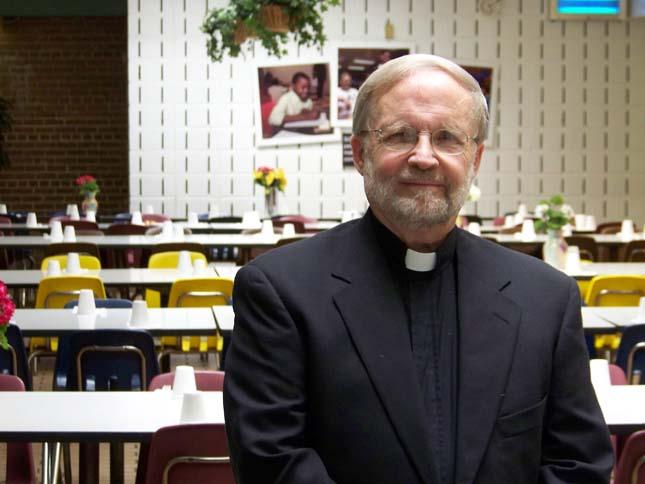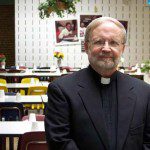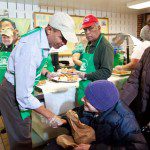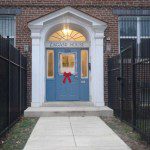“Our vision is that we go out of business,” says our July Player, Father John Adams, president of So Others Might Eat (SOME).
Adams is the only D.C. leader Bob Madigan and I have interviewed who speaks hopefully of the demise of his organization. And a glance around – inside the O Street building where we sit that provides medical and psychiatric care and across the street to the dining room that serves about 900 meals each day – illustrate the huge vacuum were even two of the 40 SOME facilities to disappear.
But Father John believes these services shouldn’t be the responsibility of a nonprofit. “Everybody that needs food should have it, everybody that needs a home should have it, everybody that need medical care should have it,” he elaborates.
“We’re probably going to be around a while,” he adds wryly, “especially as the economy is not getting better.”
A two-day electricity outage during our early June interview has closed down the dental clinic and limited medical care, and they’ve had to switch from hot meals to sandwiches but Father John appears unruffled. With an accent that hints of his original hometown of Erie, Pennsylvania, he projects calm as he voices his commitment to D.C.’s poor and homeless.
But actions speak even louder than words or, in the quote he likes to reference by St. Francis of Assisi, “Preach the Gospel at all times and when necessary use words.” And evidence of his three decades of caring and effective leadership abounds. To name just two: he was chosen as a finalist for the 2007 Opus Prize, a top international humanitarian award that brought SOME $100,000, and was selected as an Olympic torch carrier. SOME has been visited by the last three presidents; pictures show the Obama family serving lunch on Martin Luther King, Jr. Day last year.
Support (Not Just for the Celebrities)
Issues of mental health, drug abuse and addiction play out daily in the media. Politicians, journalists and actors check into rehab to cure their addictions, then surface again to promote a new show or movie. Yet for the poor these failures are more costly, often snowballing as they lose jobs, health services, safety and their homes. But our society often demonizes and depersonalizes them, viewing them as a group whose failures justify immense suffering (about 70 percent of women on the streets have been abused, as an example) and the loss of our compassion.
SOME offers deeply personalized stepping stones back to a secure and healthy life. SOME’s tagline – “restoring hope and dignity one person at a time” – and early attempts to improve food and conditions in which it was served under founder Father McKenna 40 years ago show as much.
For many, it begins with dining. The cheerful waiting room features a large screen TV showing a video of services available across the street: dental, medical or psychiatric care; support of a social worker, or help for drug addiction. After one of the two hot meals served daily, people can shower, choose from clothing donations, or remain to hear success stories of formerly homeless (20 percent of SOME staff).
“If you did it, I can do it for sure,’ they think,” says Father John, “because they knew some of these people on the streets.”
A path through SOME may include being placed in a safe house almost immediately or seeing a doctor or getting a psychiatric evaluation or dental work. Or one might join a drug treatment program of a year-and-a-half (completed successfully a high 80 percent of the time) that includes 90 days in a West Virginia facility nicknamed Miracle Mountain by its residents. Care often culminates with job training aimed at earning participants a living wage (defined by Father John as $15 per hour with full benefits).
Help Through Homes
While SOME already plays a critical role a city where one in six people live below the poverty line, their current goal, to tackle what they see as the biggest need in D.C., is even more ambitious. About seven years ago, they decided to expand permanent housing for very low income people by an additional 1000 units. Single adults, families and elderly people earning 30 percent below the median area salary are eligible. The $38 million investment – structured as a sophisticated package of loans, tax credits, tax exempt bonds and their own equity – is well underway.
Providing homes for the poor has been a circular journey for Father John. As one of seven children to an Erie family, he led a secure existence until his father was injured at his steel industry job and laid off. The tyke ended up going to eight different elementary schools as his family scraped by.
“We were the first homeless family in Erie because we lived in tents all summer long. We thought it was great,” he recalls. “My parents were very upset about the whole thing. We struggled and I think what kept us going in a lot of ways was the church, nuns, and priests that very quietly helped out or we probably wouldn’t have had anything to eat.”
He was influenced to choose a faith-based career. After attending the Divine Word Missionary high school seminary, he studied philosophy, theology and social work at Catholic University. He joined Catholic Charities in Northern Virginia and started the Christ House in Alexandria to work with poor before joining SOME as a director 32 years ago. SOME was serving about 60 meals a day, often improvising.
“When I first came we had the building across the street which was an old animal shelter and SOME had just purchased it six months before with 2 or 3 people working part-time,” he recalls. “We were struggling – the place was not in great shape. We had to often times cook on a neighbor’s stove upstairs and bring the food down. There was no hot water running.”
He was determined to get basic services and to build a volunteer presence. However, he took an unusual step, deciding to sell a house in Northeast that had been purchased for drug treatment but was unstaffed in order to buy a stove and get hot water.
Next they added dental care. Georgetown University agreed to provide full time faculty member and to require dental students to volunteer for two weeks and Washington Post columnist Art Buchwald convinced Health, Education and Welfare Secretary Joe Califano to donate dental chairs.
Over three decades they added transitional and permanent housing, state-of-the-art job training and a summer camp for seniors.
The Challenges Ahead
The deinstitutionalization movement and dramatic social cuts under President Ronald Reagan – including drastic cuts to the Department of Housing and Urban Development – expanded the homeless population in the 1970s and 1980s. The recent recession has also grown this impoverished group. Yet again this country is contemplating major cuts to health and social services, imposing sacrifices disproportionately on the poor and middle class rather than the richest Americans who have thrived these past three decades.
And while the Catholic Church has a rich trove of documents on social justice and other religions prescribe helping the poor, America, despite its highly religious population, hasn’t adopted these values as a guiding force in policy making.
Locally, the fight’s had recent success. Father John and other nonprofit leaders reversed the large majority of tens of millions of dollars of proposed D.C. budget cuts that would have affected the poor and homeless, although a huge need still remains.
For a moment, Father John gets passionate and political.
“This is supposedly one of the more powerful cities in the world but we can’t take care of our own people,” he pauses. “That says something.”
- Father John Adams








